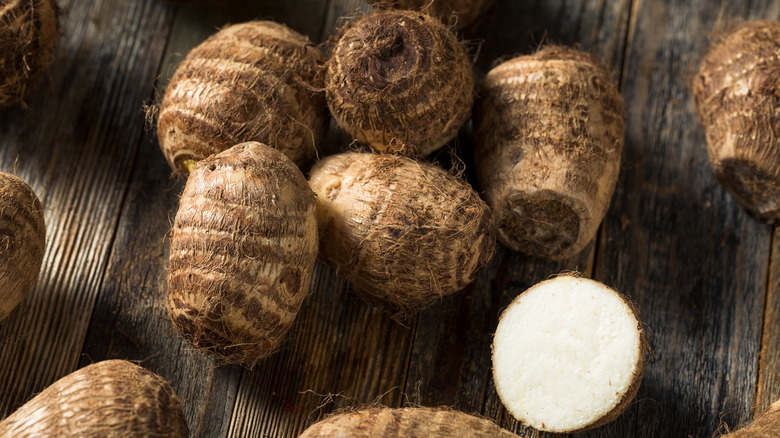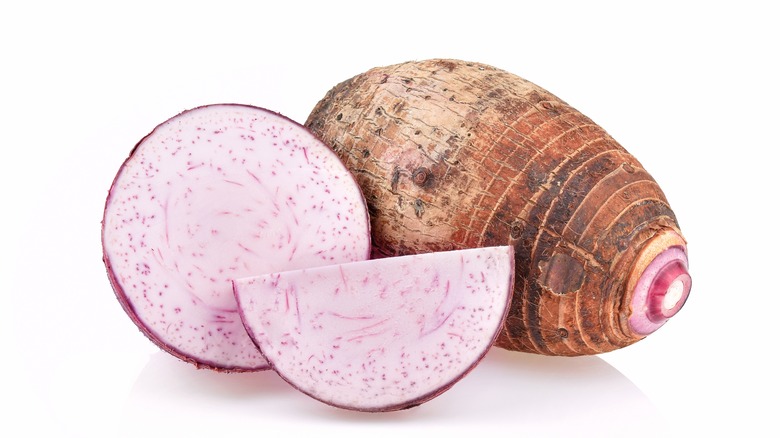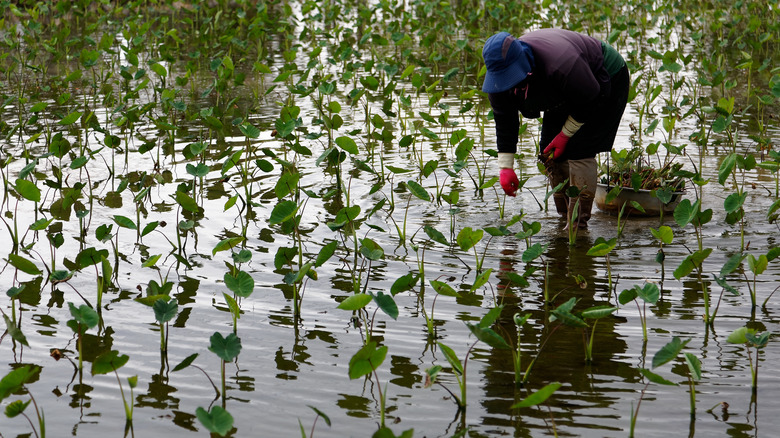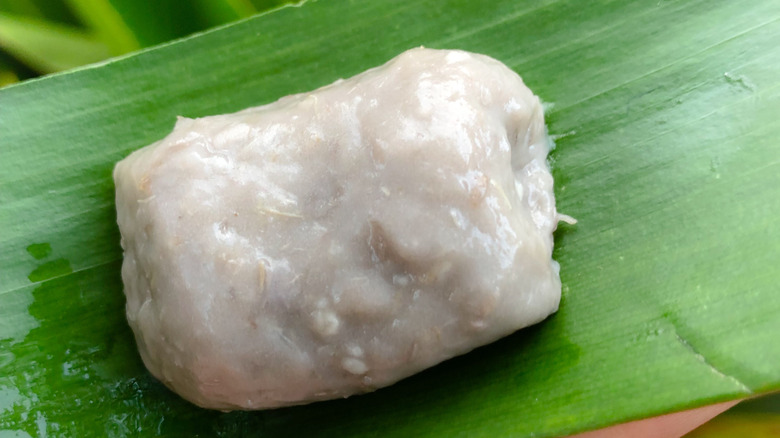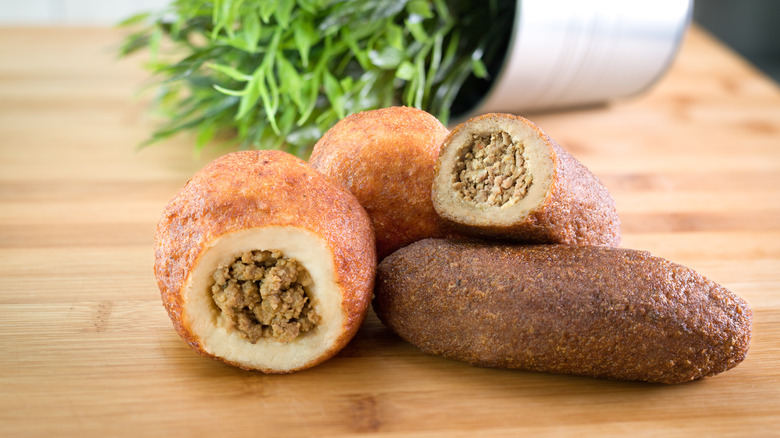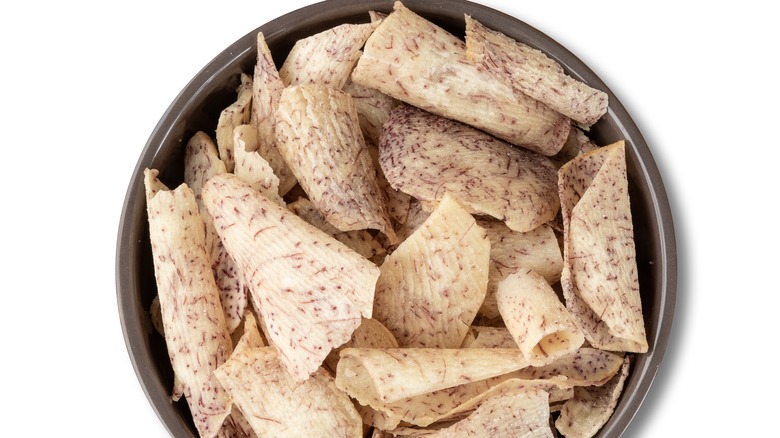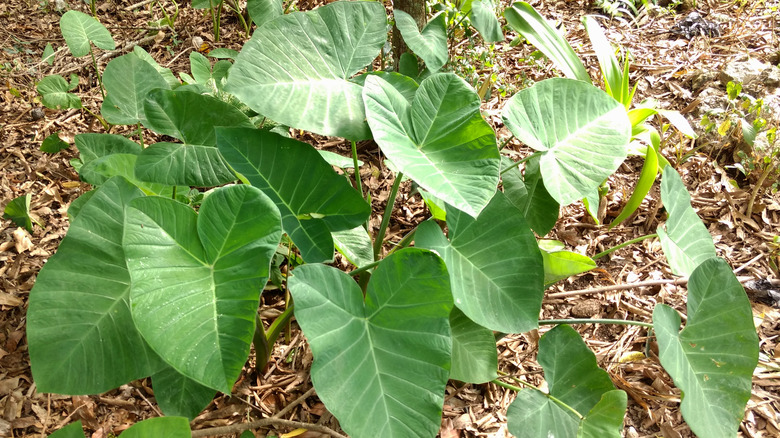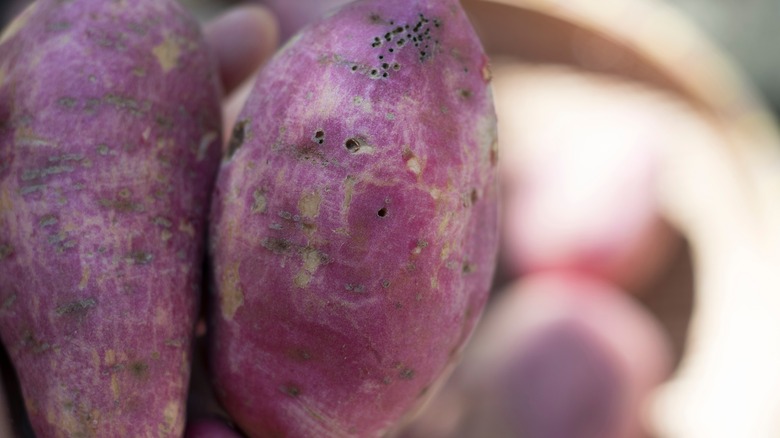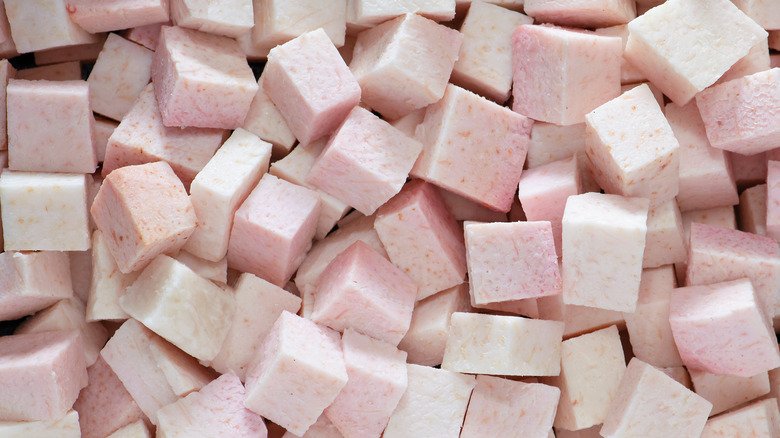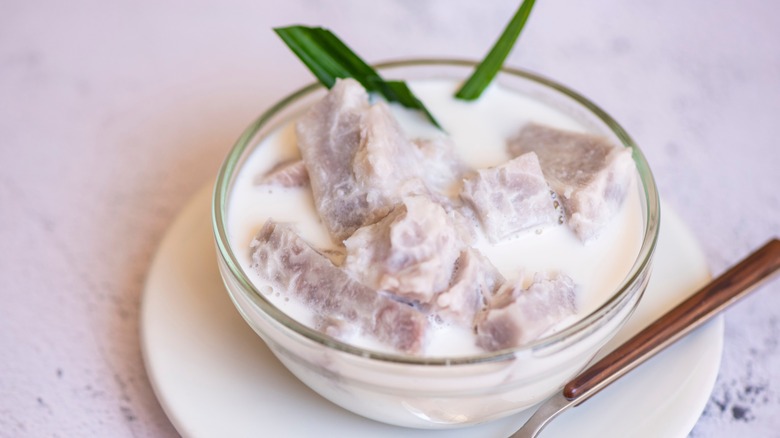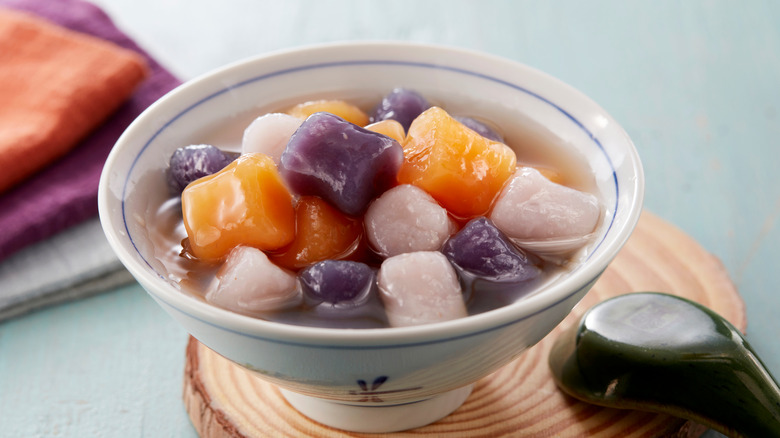Everything You Ever Wanted To Know About Taro
Root vegetables are a fall favorite since most of them can be stored for a long time and are carb-dense, which makes them quite filling. They are also low in calories, high in antioxidants, and nutritious, making them fairly healthy (via Harvard Health Publishing), especially when served in dishes such as a shaved root vegetable salad.
Some examples of root vegetables include turnips, beets, rutabagas, parsnips, yams, and potatoes. However, one lesser-known veggie in this category is taro (scientific name: Colocasia esculenta), even though it was once the root crop that dominated the world. It's a versatile ingredient found in various cuisines and cultures (some even regard it with spiritual significance) and can be used in both sweet and savory dishes. Available year-round from Hawaii and China, taro can be prepared in numerous ways — though it must be cooked, as it is toxic if ever consumed raw.
What is taro?
Although taro is lesser known in the West and not often found in American cuisine, it has a long history as one of the world's oldest crops. The root vegetable is grown in the temperate regions of Africa, the Mediterranean, Asia, and Oceania (via Ecology and Evolution). Native to Southeast Asia, taro is actually technically a corm — the underground stem part of a plant, which is harvested after seven months post-planting (via Britannica) — and not a root, despite that it is commonly referred to as the "taro root." Yet appearance-wise, it looks like a type of potato: the outer skin is dark brown, and the interior is pale, sometimes flecked with light pink-purple markings.
Taro is a versatile vegetable with a rich history and unique flavor profile that can be used in a variety of cuisines, including but not limited to desserts and savory main dishes.
History of taro
Taro has been cultivated for hundreds of years. Like peanuts, potatoes, and tomatoes that spread across the globe from their native lands thanks to intrepid explorers, it's believed that the root vegetable originated in Malaysia and then was brought to other regions — such as Egypt, Africa, and the Pacific Islands (via Speciality Produce).
According to The New York Times Style Magazine, in Hawaii, specifically, natives thrived on up to 15 pounds of poi — a traditional Hawaiian dish made from taro. But although the root vegetable was widely popular, the later arrival of Europeans in 1778 (specifically, one British captain named James Cook) introduced other starches like rice and wheat flour, which threatened to replace taro crops as a more profitable alternative for trade. However, the root vegetable still remains a dietary staple for the region. According to WorldAtlas, today, the top-three producing countries of taro are Nigeria, China, and Cameroon.
Taro in Hawaiian cuisine
Taro landed in Hawaii as early as 450 AD, thanks to the Polynesians, and is associated with Kane, the Hawaiian God of creation (via Maui Now). Today, the root vegetable is the basis of poi, a starchy staple food paste used for consumption in ceremonies and medicine, as well as local cuisine. According to Science Direct, poi was traditionally handmade by families, who used a wetland variety of taro, called kalo. One indigenous group, the Kanaka Maoli, holds the root vegetable in the highest esteem: they believe it has an immense life force.
To create poi, corm is harvested and then steamed in an underground oven, transforming the ingredient's color from pale cream to a mauve purple color (via YouTube). Next, the peeled kalo is ground and mashed up with a large stone tool (reminiscent of a mortar and pestle). Once a sticky paste texture is achieved, water is added to "stretch" the substance, which remains edible for days and even weeks, though after one day, the poi acquires a tangy flavor due to souring.
According to The New York Times Style Magazine, modern Hawaiian chefs are reclaiming taro and incorporating the ingredient into their menus, reimagining the tradition of its preparation.
Other cuisines that use taro
According to FoodPrint, around the world, taro is known by many other names in the different cultures that cook with the corm. For example, in some regions, it's known as eddo, which is technically a bit hairy, smaller, and rounder than the standard taro variety (via Brooks Tropicals).
In various cuisines, it is used in savory dishes like root cake, stir-fried with meat, boiled in soups or hotpots, and used to make tapioca or other desserts. In the indigenous Taiwanese Tao tribe's culture, it is traditionally prepared with pork lard during the fishing season. It is given as a gift when newborns arrive or when people move homes (via Culture Ready).
Over in the Caribbean, taro is known as malanga or yautía, which are longer varieties with a bumpier, patchier, and shaggier outer skin and nutty flavor (via John Vena Inc. Specialty Produce). Malanga is a favored ingredient in Cuban and Puerto Rican cuisine as well and is included in dishes like the traditional stew sancocho, mondongo (another type of stew you can try in Bogota, Columbia), pasteles, and alcapurria. In West Africa, a dish called fufu uses taro; in Western countries, taro chips are readily available at most grocery stores.
Nutritional benefits of taro
There's a reason why the native Hawaiians of yesteryear were able to eat massive quantities of poi without negative effects: taro is a nutritious corm, full of fiber, potassium, magnesium, and vitamins C and E (via healthline). One cup of the prepared root vegetable contains 187 calories, and though carbohydrates make up most of this amount, the carbs are considered "resistance" starches, which don't raise blood sugar levels like other carbs. The starches also serve as food for the good bacteria in our microbiome, which makes taro an ideal food for optimal gut health. Another benefit from its high fiber content (more than 6 grams per cup) is that the corm may help reduce the risk of heart disease and prevent excess weight and body fat.
Finally, taro also has plant-based compounds (or polyphenols), the main one being quercetin, which may potentially reduce the risk of cancer (via International Journal of Molecular Medicine). According to Healthy Options, taro chips are also a healthier alternative to potato chips.
Varieties of taro
According to Science Direct, Taro tends to be split into two main categories: upland (eddoe) and wetland (dasheen). While both types may seem similar, there are still many different varieties that exist within them. One report published in 2008 by the Livestock Research for Rural Development found that there are over 200 species of the root vegetable, though most fall into the category of the kind grown in wetlands. Wetland taro is often cultivated in the Pacific Islands, while upland taro consists of eddo and other Eastern varieties.
Though the corm has a long history of being farmed as a crop, the difference between wild taro and farmed taro is nearly impossible to discern due to the varied and polymorphic nature of the root vegetable, according to Chow Tray. For the same reason, classification is also difficult, though recent evidence shows that there may be more types of wild taro out in the world.
Differences between taro and ube
When steamed and mashed, taro takes on a purple hue; it may be confused for another starchy root vegetable: ube, or purple yam. Ube is generally sweeter — the taste is oft compared to vanilla or pistachio. As a result, unlike taro, it is more often found in desserts over savory dishes. It has been used as a flavor in pancakes, cakes, ice creams, bubble teas, drinks, donuts, and more.
To tell ube and taro apart without a taste test, all you need to do is to look at the outer skin and perhaps cut the vegetable open if you're unsure. Ube has a light brown, roughly textured outer layer with distinctive purple flesh. Taro, on the other hand, has a hairy outer layer and the inside is a pale creamy color.
If you're in a pinch and a recipe calls for taro but you don't have any on hand, you can use sweet potato, Japanese sweet potato, yucca, or even parsnip as suitable substitutions — though parsnip might not work so well in dessert recipes.
Where to buy and store taro
Although taro is quite solid and durable, it does have a tendency to soften quickly. To ensure you select the best taro, inspect the outer layer for any blemishes, mold, wrinkles or soft patches; if you see any of those flaws, skip over them for options with a pink or white-greenish stem at the end, which signals freshness (via Harvest to Table).
For storage, skip the refrigerator and instead keep the root vegetable in a cool, dark place with good ventilation. To store taro leaves, you can place them into a perforated plastic bag and refrigerate. Another option is to purchase the corm frozen, pre-peeled, and cut into chunks that are ready to be defrosted and used straight away. This can be found at speciality stores like H Mart, or you can prepare and freeze the taro yourself and store it for up to three months (via Freeze It).
How to prepare and cook taro
The most important thing to know about cooking with and consuming taro is that it can never be eaten raw — stem, leaves, and all. Every part of the root vegetable must be cooked prior to consumption. And this can take place in so many ways: boil, steam, stir-fry, bake, or braise the ingredient (via Harvest to Table).
To prepare taro before using it in any recipe, you must peel its outer layer first. For easier cooking, it's typically common to cut the root vegetable into chunks. If you'd like to incorporate more greens into your diet, young taro leaves are also edible and can be consumed like mustard or turnip greens. For example, for this mustard green and roasted sweet potato recipe, try substituting the potato for taro and use the root vegetable leaves in place of the greens to use the entire plant.
Popular dishes made with taro
If you don't have access to fresh taro or a giant stone tool and a wooden board to make Hawaiian poi from scratch, you can still test out the root vegetable by using its leaves in this steamed black cod with sweet potatoes and dried shrimp recipe from Chris Kajioka. For those more interested in testing the corm itself, test out this traditional dish: Hawaiian pa'i'ai with lychee, ho'io, and dried shrimp.
You can even use taro in Indian cuisine: One Indian religious rite, shraadha, involves eating a meal on the anniversary of the death of a loved one. The ingredients? Raw banana and its stems, broad beans, sweet potatoes, unripe mangoes, veld grape, and taro roots.
Finally, for those looking to try taro without getting messy in the kitchen, consider checking out Taiwanese street foods, many of which contain the ingredient, like tapioca taro dessert.
